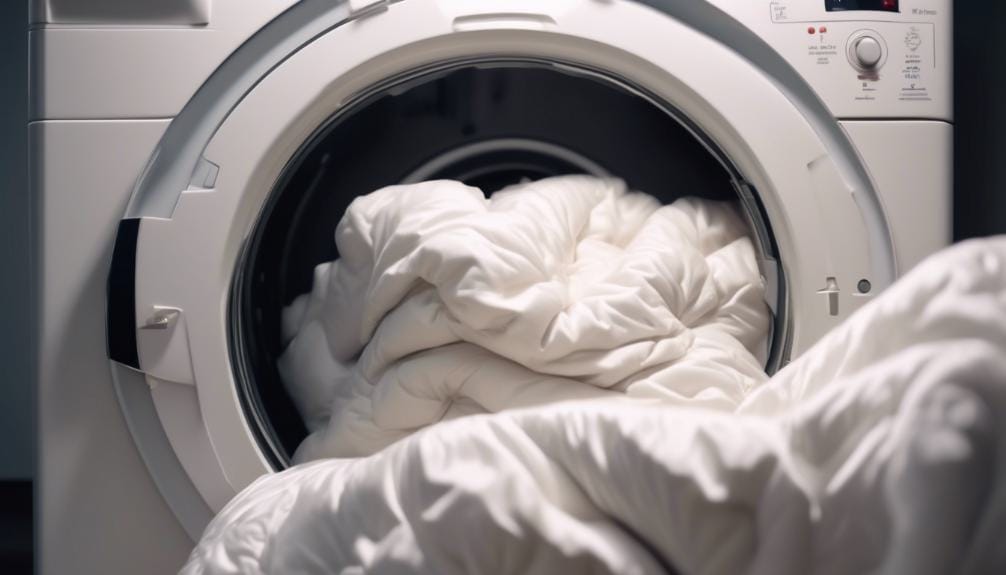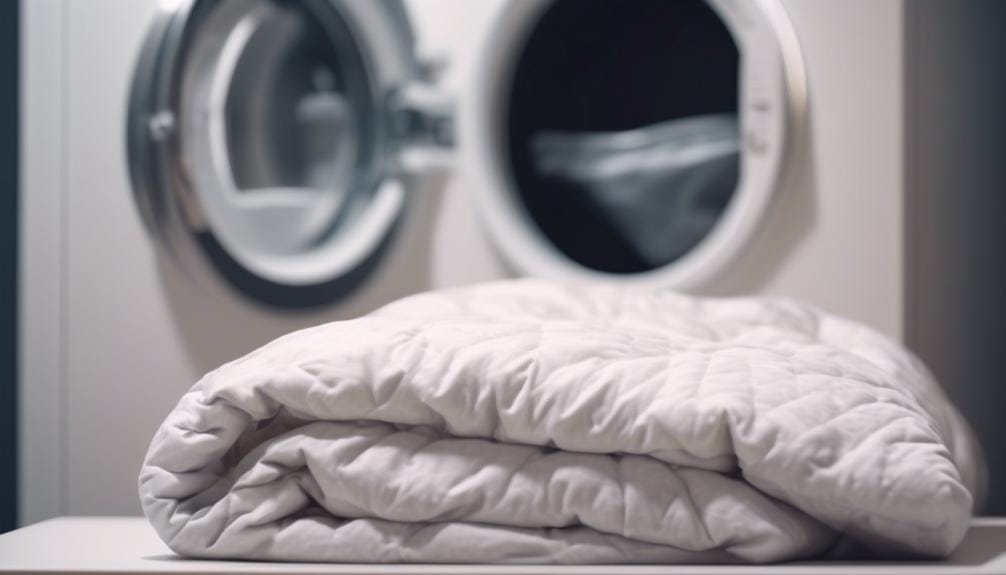Can You Put Duvet in Tumble Dryer? Care Tips Unveiled
Did you know that almost 60% of people have admitted to using a tumble dryer for their duvets despite the potential risks? You might be tempted to toss your duvet in the dryer for convenience, but hold on. There are important care tips to consider before you do.
The question remains: can you put a duvet in a tumble dryer without causing damage? Let’s uncover the best practices for caring for your duvet and ensuring it stays fluffy and cozy for years to come.
You won’t want to miss these essential care tips that will keep your duvet in top condition.
Key Takeaways
- Fill the tumble dryer two-thirds full for proper and even drying.
- Use a low or medium heat setting to extend the duvet’s life.
- Ensure the duvet is completely dry before using or storing to prevent mold and mildew.
- Regularly air out the duvet outside four times a year to keep it fresh.
Tumble Drying a Duvet

To ensure proper and even drying, only fill your tumble dryer two-thirds full when drying your duvet. This allows enough space for the duvet to move around and dry thoroughly.
Use a low or medium heat setting to prevent damage and extend the life of your duvet. It’s crucial to follow the manufacturer’s instructions for washing and drying your duvet to maintain its quality.
Ensure that the duvet is completely dry before using or storing it to prevent mold and mildew.
Additionally, regularly air out the duvet outside four times a year to keep it fresh.
Selecting the Right Cycle and Heat

When selecting the right cycle and heat for drying your duvet, refer to the tag for recommended settings to ensure proper care and longevity. Using low or medium heat can extend the life of your duvet, especially if it contains natural fillings like feathers or down. Some dryers even have specific settings for duvets, so be sure to check for these options. It’s crucial to avoid hot heat, as this can damage the natural oils in down fillings. Follow the manufacturer’s specific instructions for the duvet, including any guidance for cleaning and care. Consider using wool dryer balls to help fluff the duvet during the drying process. Below is a table to summarize the key points for selecting the right cycle and heat for drying your duvet:
| Considerations | Recommendations |
|---|---|
| Heat Level | Low or Medium |
| Dryer Settings | Check for duvet-specific options |
| Natural Fillings | Avoid hot heat to preserve oils |
| Manufacturer’s Instructions | Follow for specific care |
Maintaining Duvet Fluffiness

Achieve optimal fluffiness for your duvet by incorporating a few simple maintenance techniques into your routine.
When tumble drying your duvet, add a couple of clean tennis balls to the dryer to help fluff the duvet and prevent clumping. Use a low heat setting and a dryer with a large capacity to allow for adequate airflow.
Always follow the manufacturer’s instructions for washing and drying, using warm water and a mild detergent. During the drying process, periodically stop the cycle to shake and fluff the duvet to ensure that it stays fluffy and evenly dried.
After the tumble drying cycle, hang dry the duvet for a few hours to guarantee complete dryness. Additionally, regularly airing out the duvet can help maintain its fluffiness and reduce the need for frequent washing.
Drying Time for Duvets

Ensure your duvet is thoroughly dried to maintain its quality and prevent any potential damage.
The drying time for duvets varies based on the type of dryer and the materials. Feather duvets, for example, may take longer to dry than synthetic ones. If using a tumble dryer, consider adding a couple of clean tennis balls to help fluff the duvet as it dries.
Follow the care instructions provided with your duvet, as some may recommend air drying or professional dry cleaning. It’s essential to use low or medium heat settings to avoid damaging natural materials and to periodically check the duvet to ensure it’s completely dry.
Hang drying the duvet for a few hours after the cycle can also help ensure complete dryness and prevent clumping of the filling.
Care Tips for Washing and Drying Duvets

To maintain the quality and longevity of your duvet, it’s crucial to follow proper care tips for washing and drying. This includes ensuring thorough drying to prevent potential damage and maintain the duvet’s integrity. When washing a feather duvet, make sure to follow the care label instructions and use a mild detergent. Here are some essential care tips for washing and drying your duvet:
- Ensure the duvet is free of soapy residue before putting it in the dryer
- Only fill the machine two-thirds full to avoid uneven drying
- Use a low or medium heat setting to extend the life of the duvet
- Dry the duvet until it’s completely dry to prevent mold and mildew
- Follow the manufacturer’s instructions for the specific duvet
Following these guidelines will help you keep your duvet clean and in top condition for a long time.
Frequently Asked Questions
Can I Dry a Duvet in a Tumble Dryer?
Yes, you can dry a duvet in a tumble dryer. Check the tag for recommended settings. Ensure it’s free of soapy residue. Use tennis balls to prevent clumping and adjust drying time based on the type of dryer and duvet filling.
Can I Throw My Duvet in the Dryer?
Yes, you can put your duvet in the dryer. Check for soapy residue before drying, use recommended settings, and consider adding tennis balls to prevent clumping. Always follow the manufacturer’s care instructions for the best results.
Why Can’t I Tumble Dry My Duvet Cover?
You can’t tumble dry your duvet cover because it can damage the fabric and cause shrinkage. Air or line drying is best to maintain its quality. Follow the care label instructions for proper maintenance.
What Is the Best Dryer Setting for Duvet Cover?
Select the low-heat setting for your duvet cover in the dryer. This helps prevent damage and ensures the cover dries thoroughly. Using this setting will keep your duvet cover in great condition for a long time.
Conclusion
In conclusion, it isn’t recommended to put a duvet in a tumble dryer as it can damage the filling and affect the fluffiness. It’s best to hang dry a duvet or follow the manufacturer’s instructions for drying.
By taking proper care of your duvet, you can ensure it stays fluffy and comfortable for a long time. Remember to select the right cycle and heat, and follow the care tips for washing and drying to maintain the quality of your duvet.
